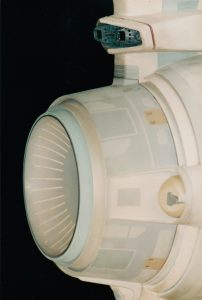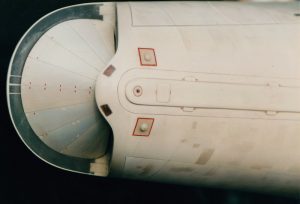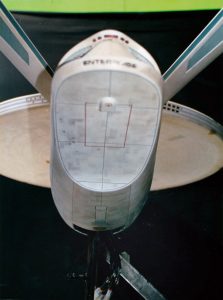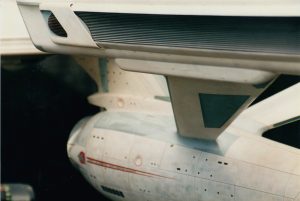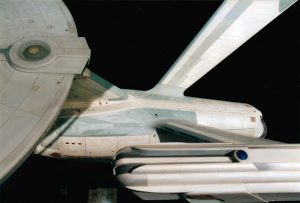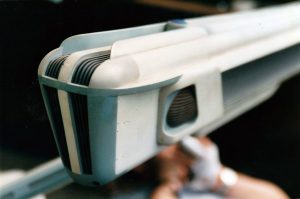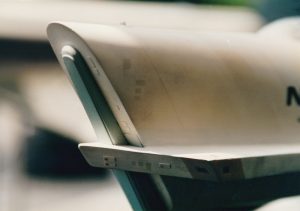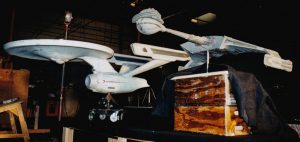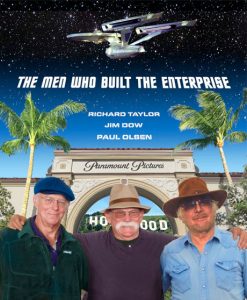
Last time: We met Paul Olsen, the man who spent eight months back in 1978 and 1979 painting the original model of the refit USS Enterprise for Star Trek: The Motion Picture. Now, 37 years later, Paul wants to build it again: bigger, stronger, better, and painted to have the same opalescent shine as the original.
And Paul won’t be doing it alone. Richard Taylor (who designed the refit Enterprise) and Jim Dow (who built the original model) will be part of the team, as well. And the cost for this rebuild: $3 million!!! (They intend to build a 12-foot model that will last for hundreds of years plus a virtual reality display room that can be transported around the world.)
Right now, Paul and his team—with the help of Nichelle Nichols, Rod Roddenberry, and Tim Russ—are trying to raise $50,000 through a Kickstarter campaign ending on September 11. That will go towards a PR tour where Paul will attempt to raise the millions of dollars he’ll need to make this Trek fan dream a reality. He’s also trying to get official authorization for the project from CBS licensing, and that’s where we’ll pick up our interview, already in progress…
Paul: I’ve contacted John Van Citters [at CBS Consumer Products] via e-mail, and he’s looking into our project and whether they can authorize us.
Jonathan: What if John and CBS say no?
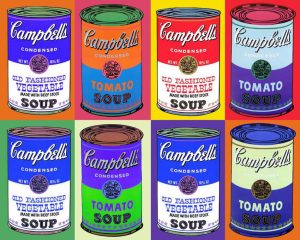 Paul: Well, Andy Warhol established back in the 60s when he did the Campbell’s Soup cans…and Campbell’s sued him, and it went right up to the supreme court. And he said, “Look, I’m an artist. I can do whatever the hell I want. You can’t stop me from doing anything. I don’t care whether it’s trademarked or copyrighted or not.” And he won, and Campbell’s lost.
Paul: Well, Andy Warhol established back in the 60s when he did the Campbell’s Soup cans…and Campbell’s sued him, and it went right up to the supreme court. And he said, “Look, I’m an artist. I can do whatever the hell I want. You can’t stop me from doing anything. I don’t care whether it’s trademarked or copyrighted or not.” And he won, and Campbell’s lost.
So as an artist, you can make one of anything. If you make more than one, and you’re selling it, then you’re in trouble. It’s a different thing than a film, because a film goes out to lots of different people and it competes directly with what CBS is doing…whereas we’re reconstructing the model.
Two years ago, I spoke with Bill Burke at CBS when I was just in the infancy of putting this all together. And I said, “What do I have to do to get authorized by CBS so you can license us?” And he said, “If you get this going, and the Enterprise is finished and she’s out on the road and your taking fees for her, then we’ll talk, and we’ll do a licensing arrangement.”
Jonathan: So your intention is to license. Once this is all done, you’re not just gonna go take the model on the road and charge money for people to see it and hope that CBS doesn’t sue you for it. So if the model still isn’t built yet, why are you contacting John Van Citters now?
Paul: I’m only seeking authorization right now, not a licensing agreement.
Jonathan: What’s the difference?
Paul: Did you see the commercials that Enterprise Car Rentals did tying into Star Trek?
Jonathan: Yeah, they were a lot of fun.
https://www.youtube.com/watch?v=k7_4vl95So8
Paul: Well, I contacted them…the people who put the commercial together are in Burbank. And I said, “Here’s my PR program. For $450,000, you can have three years of unlimited PR. You can do whatever you want regarding us as we’re building the Enterprise. You can come in; we’ll have your logo on our lab coats. You can use us any way you want to for the first two years of rebuilding and then the first year out on the road.”
And they loved the idea. Then they came back to me and said, “You’re not authorized by CBS, so we can’t move until you’ve got that done.” So that’s my next step with John Van Citters. Obviously, we want to work with CBS ‘cause we’re both on the same team.
Jonathan: So I’m still wondering about the cost of building the model itself. Three million dollars is a lot of money to raise. Is there a way to build it more cheaply?
Paul: Jonathan, it absolutely has to be done right. And to do it right, it’s gonna take as long as it took before. And then we have the display to do. We want to create something that’s going to last three to four hundred years.
Jonathan: I’ll be lucky if my car lasts for 20 years! But then again, it didn’t cost three million dollars.

Paul: We’ll get the money; don’t worry. But first I have to get the awareness out in the world as to what we’re doing. And right now, not many people know about it. And it’s going to cost money to do that. And that’s why I’m raising this money in this Kickstarter in order to get out there and do it on the back of a real hot PR company that can keep me busy every single day. And then, once we’re out there and getting noticed, bringing in sponsors will be a piece of cake. If I can get authorized by CBS, I can probably get EHI (which is Enterprise Holdings International) on board, and also Nissan because they use the Enterprise in their advertising over here in the U.K. And there are probably lots of other companies around the world who are using the Enterprise in some way themselves and would be interested in joining with us.
And then there’s the documentary, which’ll help fund it, too.
Jonathan: Documentary?
Paul: We’re going to be doing a feature documentary that Richard Taylor, who designed the Enterprise, will be directing…right from the get go. And the fee for that—we’ll either do a deal with Netflix or the Discovery Channel or somebody like that—that’ll be three to four million right there. So that’ll take care of the funding. But I’ve got to get the initial four or five hundred thousand dollars together to get premises, to bring in all the tools, and get the personnel together.
Jim’s done this so many times because he has his own display business down in Costa Mesa. And he says, “Paul, it’ll take two months to fully kit out a shop.” And we’re not just talking a shop. We’re talking a shop that also has to be a studio…because for the feature documentary, we want this to look absolutely the business. So think: Formula One garage—that kind of pristine, perfect place to construct a racing car. Well, we’re gonna construct a space ship, but it’s not going to be any different than that in terms of the look. So getting all that set up is going to take two months. And then we start the build.
So four hundred and fifty grand will buy us about four or five months altogether. And during that time, I can negotiate the feature documentary rights, publishing rights, and all the rest of it that brings in money and be dealing with potential sponsors like SpaceX or American Airlines or Boeing…suitable companies like that.
Jonathan: So before we wrap up, as a geek, I just want to ask you about the Enterprise paint job that you did. I think we can all agree that the beauty shots of the refit starship looked the best in Star Trek: The Motion Picture. And I know that some of the VFX shots in Star Trek II: The Wrath of Khan were the same shots as in the first movie. But for the exterior shots that were unique to Trek II, the Enterprise didn’t look nearly as good. Was it just the lighting, or did they repaint the model…what happened?
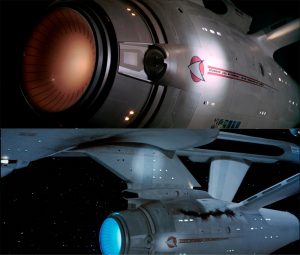
Paul: Doug [Trumbull] said to me when we first got the ship all lit, “Paul, we can’t use blue screen to shoot this.” We had to use a different method, called white screen, because the model had every color of the rainbow in it depending on where the camera angle was! As your line of sight moved, and your angle of incidence light changed, it sparkled and it changed color. It was absolutely stunning!
Jonathan: I’ve heard of blue screen and green screen, but I’m not familiar with white screen…
Paul: White screen is difficult. It was twice as much shooting because you have the model in front of a white screen that’s lit, and the model is silhouetted against the white screen. And you use a black and white Ortho film, bi-packed in the camera, so you’ve got positive film and negative film in the camera bi-packed together. And you take the shot, and that creates your matte and your window. And then you do your beauty shot after that. Whereas with blue screen, you can do your beauty shot in one go.
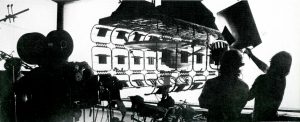
Jonathan: And what is Ortho film?
Paul: Ortho film is a black and white film that either goes black or it goes clear. There’s no gray values in it at all. So if you expose it right, you get black, and where you have no exposure, you get clear. And then on the positive film, it’s just the opposite. And when you bi-pack them together, then they match up exactly. You’ll still get matte line slightly, but it’s pretty good. But it’s a tedious way of shooting a model. But it’s the only way we could shoot the Enterprise and get all the colors and still get all the mattes and the backgrounds dropped in.
Jonathan: Wow, life before computer generated imagery! So I take it they didn’t use white screen for Star Trek II then?
Paul: Lucasfilm did the second movie, Wrath of Khan, and they used blue screen. And of course, there was blue everywhere on that model. So they had to kill the pearl paint job, and then they repainted the Engineering section—what the model makers call the “strongback”—all the pale greeny-blue color that’s around the front of the secondary hull and on the pylons and across the back of it. And they redesigned that. And so it wasn’t the original ship anymore.
And then, with each successive film, they began to be able to fix everything in post. So people go their grubby hands on it, it got knocked around, and it didn’t matter because they could tweak it in CGI ’cause CGI was coming along.
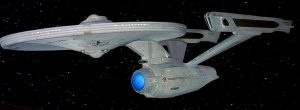
And I saw, when the model was wheeled out at Christie’s in 2006…I just couldn’t believe it. Two clowns wheeled that baby out on a piano dolly, and they each had their grubby hands on the nacelles, and they were just pushing it out. It was a travesty. God knows how bad the model looks now, but it doesn’t look anything like it looked when it left my hands.
Jonathan: I actually had a chance to see and photograph that model up close about 16 years ago back when Foundation Imagining was doing the remastered CGI visual effects for the director’s cut re-release of The Motion Picture. I had a friend at Foundation at the time, and I shot about two rolls of film. Maybe I’ll include some of those photos as a bonus feature with this interview.
Paul: I’d love to see them!
Jonathan: Well anyway, Paul, let me thank you for a great interview. It’s obvious that you care deeply about Project: Enterprise, and it sounds like you really know what you’re doing. There’s that old Vulcan saying that only Nixon could go to China. And I think that only the original builders of the movie Enterprise could make a $3 million recreation become reality. So what can folks do to help you out?
Paul: Right now, just please donate to our Kickstarter. We’ve got to raise $50,000 by September 11, and we’re already more than a quarter of the way there. We have some great perks that your readers should check out.
The fact is that the Enterprise is the most famous movie icon ever created. And it no longer exists…for all practical purposes. And to me, that’s insane. So we want to rectify that, and the Enterprise we’ll create will be 50% larger—it’ll be12 feet long rather than 8 feet—and have all modern electronics and LEDs. It’ll be a Star Trek fan’s dream come true!
Jonathan: Well, Paul, you’ve convinced me. Now let’s hope you can reach than $50,000 goal to move onto the next phase of your project. Best of luck to you!
Paul: Thank you so much, Jonathan.
To donate, click here to and visit their Kickstarter page.
And here are the rest of the best pictures from when I photographed the actual refit Enterprise model back in 2000:

